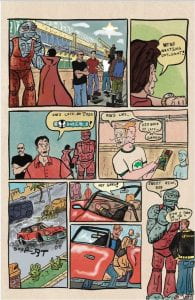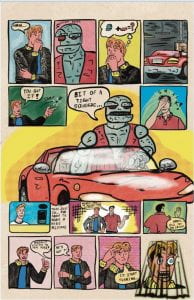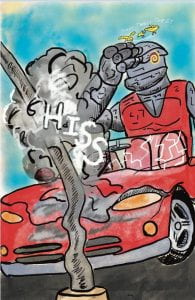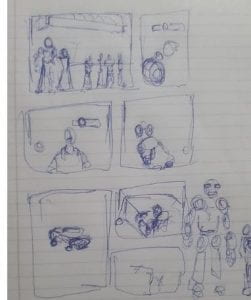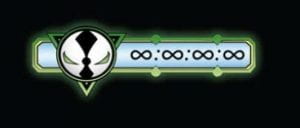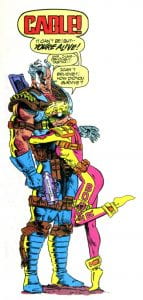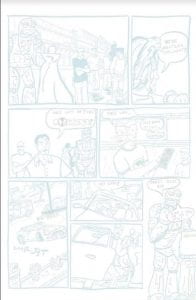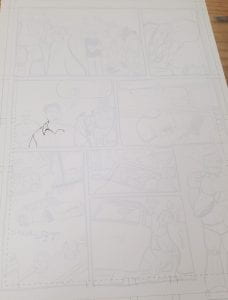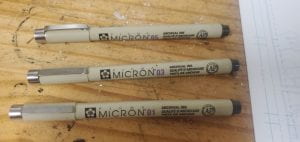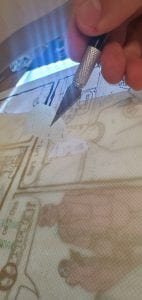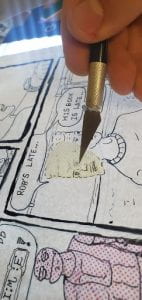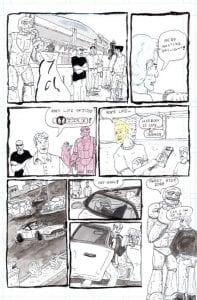By: Graham Millar, Art Editor
When I was a sophomore I took CMLIT 415, ‘The World Graphic Novel’. Having read comics all my life, I loved this class and the breadth of all the different selected readings. I have been making comics to various levels of completion since I was a kid, but whether it was disappointment with the quality of my work, or my tendency to become distracted by new ideas, I could never complete a full thought on the page. The final project of CMLIT 415 came with the limitation that the story could only be a maximum of two pages. Unfortunately, I’ve long since lost those two pencil pages of 8 1/2 by 11, but I certainly didn’t lose the skills required to complete them. I had no idea how to approach the page and I scrambled to squeeze the story into 18 panels. I just made them up as I drew them, and I decided to write in the dialog later. I published my first mini-comic ‘Mozzarella: A Rumble in the Jungle’ last March, and I’ve drawn around 100 or so as of yet unreleased pages on the app Procreate, because it makes the process just so much quicker.
That being said, I miss my pens, my brushes, my ink, my blades, my zipatone screens, and I miss the bristol board paper that I drew my first finished comics on. My process isn’t just limited to these tools. Cartoonist Kayfabe, a YouTube channel hosted by Pittsburgh cartoonists, Ed Piskor and Jim Rugg, has kept me company through the many solitary hours I spend drawing pages, as well as any kind of artistic documentaries I can find for free online. Cartoonist Kayfabe isn’t just a YouTube channel. It’s an online community of amateur and professional creators, and in the past year we’ve been working on some pretty big projects. When I wrote this article initially, I was awaiting the shipping notification on my complimentary copies of the book, and with their arrival I must say they look spectacular.
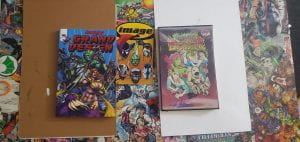
Image Grand Design cover by David Brouwers presented with its flipside, Image Grand Disaster, cover by Chris Anderson
Image Grand Design & Disaster is a non-profit anthology comic that unites all of the loosely connected main titles that Image Comics launched in 1992 and ties them into one continuity. This project involved nearly one hundred creators across the world, and like my CMLIT 415 project, I only had a few pages to tell my story. I drew a three page strip about a real event involving Image Comics co-founder and Deadpool creator Rob Liefeld, and the infamous Dodge Viper crash Dan Panosion recounts in the documentary The Image Revolution. Rob bought a new car; he let a man dressed his character ‘Badrock’ a large, hulking, superhero take that car for a spin….I’ll let you read how that turned out below.
The images above were all drawn and colored in Procreate, but I thought I would re-make the first page on bristol board so that I could explain some of the more interesting pieces of analog comics creation.
First I break down the action that I want to represent on each page in loose thumbnail sketches on plain notebook paper. I prefer notebook paper to sketchbook or printer paper because I find the blank white piece of paper somewhat intimidating.
Two important components of the page I wanted to include in this sequence were the ‘Spawn-o-meter’ and an ‘anchor image’ for the page. The ‘Spawn-o-meter’ is a repeating motif from Venom creator Todd McFarlane’s comic that measured the power level of his protagonist. Todd was one of the few artists that kept his comic on a consistent release schedule so I wanted to include the ‘Spawn-o-meter’ as Todd’s internal clock.
An ‘anchor image’ is a striking, dynamic or full body shot of a breakout character that the Image Comics founders were prone to include in many of their pages to drive up the price of the original art. I based my anchor image of Rob and the man in the Badrock costume off of this image of Cable and Boom Boom that Greg Capullo drew for an issue of the series ‘X-Force’. Cable is another character created by Rob and Greg Capullo makes a cameo in my three page strip. He’s the bald man with sunglasses.
For my analog recreation of this piece, I started by printing out the strip that I had drawn in a 10% cyan blueline reproduction. This is a new process for me, but it’s something I’d like to do more often. This is often called ‘non-photo blue line’ as the light ink is difficult to capture via photograph and almost completely invisible to scanners. Before I worked digitally, this step would have been done entirely in pencil. Below is a comparison of the digital blue line file, and the printed blue line layout on bristol board.
From this point I ink most of the line work with PIGMA Micron pens. I’ve rotated through many different types of pen, but I chose to work with Microns for this piece, because it’s what Rob used to draw a lot of his early Image Comics.
05 is the widest so I try to use that on the outlines, 03 for facial and clothing details, and 01 for eyes and eyebrows specifically, but to be totally honest, I did occasionally forget which one I was holding or mixing up the caps, and by extension, the pens. I also mentioned Zipatone screens, which is a tool I was unfamiliar with until about a year ago. Zipatone is a plastic film with a dot matrix or other pattern that is cut and placed onto the bristol board to create a grey effect. I primarily used it in this piece for background elements, and glass panes. Below is a little brief tutorial on this process.
These color zipatones are pretty unorthodox as most original art is scanned in black & white or grey-scale, but I received them as a birthday gift and I thought this would be a fun piece to use them on.
Finally, I used an ink wash to fill in a lot of the grey scenery like the parking lot, and portions of Rob’s car. I rarely measure the dilutions of ink and water that I use in these washes. Below is the completed scan of this analog recreation of page one of the ‘Viper Crash’ comic strip.
Penn State offers multiple classes investigating comics beyond CMLIT 415, such as The Craft of Comics (ENGL/AA-193), The Comic Book: A History of Sequential Art (ARTH-226), The Graphic Novel (ENGL-193), and ENGL 106 where students participate in picking the recipient of Penn State’s Lynd Ward Graphic Novel Prize.
Meet Graham Millar, our Art Coordinator for this year at Klio!! He is an English Major at Penn State and an aspiring cartoonist. Some would say that Graham draws comics in his free time, but Graham doesn’t consider that his free time—it’s his vocation. He completed his first mini-comic, ‘Mozzarella; Rumble in the Jungle’ last February. Graham has a vested interest in professional publishing. Graham believes a book can function as an art object, and not just a nice story. Fortunately, Graham also has an appreciation for arts that aren’t printed on pulp-paper.
